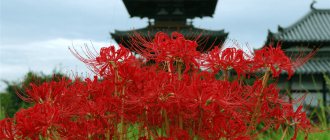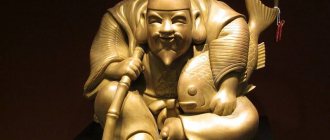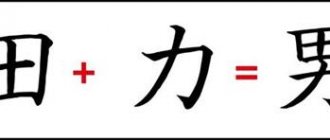Sakura (桜)
Who doesn't know about sakura, known as cherry blossoms? These flowers are so beautiful and so attractive. Cherry blossom is the flower of any of several trees in the genus Prunus, which is known as Japanese cherry. So, what does Sakura symbolize then? Sakura symbolizes chastity, love, affection, purity and good luck. Sakura - kindness, politeness, nobility.
You may have heard the Japanese word "Hanami" (花見). The word "Hanami" comes from two words: "Hana" (花), which means flowers, and the word "mi" (見), which means to look or look. So it literally means looking at flowers, “flower admiration.” Which flowers? The most common flowers they like to admire are sakura. This means that if Japanese people say they will go to Hanami, it usually means they will go to Sakura's. Hanami is a very short-term pleasure, lasting about 7-10 days, and then the petals fall. His procession of ume (Japanese plum) flowers begins. After ume, sakura blossoms.
Hanakotoba - Japanese language of flowers
After participating in the prose competition, I suddenly wanted to write. And I decided to write a review. I haven’t done this for a long time) My choice fell on the web manhwa “Nineteen, Twenty-One” (authors Yohan and Kim Hye-jin). This is one of my favorite jobs. What made me fall in love with her were the flowers that became the headings of each chapter. And they are beautifully drawn. I always pay attention to flowers, because I can somehow draw only them)) Reflecting on the review, I remembered the language of flowers and decided to find out more about it. I became interested in Hanakotoba, the Japanese language of flowers. The meanings of some colors surprised me. These flowers have always evoked other associations in me. Interesting to know your) Color meanings according to hanakotobe:
- Amaryllis means modesty. (Only the Japanese can call this flower modest))
- Primrose symbolizes despair. (She seems happy to me)
-
-
-
Tags: japan, flowers
| Previous post: Children's pearls - 3 | All posts by Reikon | Next post: Member |
Comments (16)
Gyulbesheker 14:01 01/04/19
There's also lycoris. See the manga "Tokyo Ghoul")) The Japanese have a lot of meanings for flowers. They are connected with the color, and with the shape of the flower, and with legends, and with the similarity of the hieroglyphs denoting them with something. There are a lot of colors in girl's mangas and in the Amatsuki manga, where there is just a sea of symbols that are incomprehensible to non-Japanese. Somewhere they are explained, somewhere you “figure it out for yourself.” White chrysanthemums are an ambiguous symbol. It is often given as a birthday gift to older people. And not at all in order to remind them of death. On the contrary, chrysanthemum is a symbol of longevity and health. because it lasts in a bouquet much longer than any flower. Chrysanthemums are also a symbol of Japan because they resemble the radiant sun. And Japan is the land of the rising sun. The chrysanthemum is the symbol of the emperor, who placed it on his coat of arms and clothing. This flower is even present on Japanese passports. Would they put flowers of death on passports? At funerals, chrysanthemum is present precisely as a symbol of life. Let it be from beyond the grave. And kamikaze pilots tattooed her for this purpose too.
Reikon 01:07 01/04/19
Gulbesheker, thanks for the addition. For some reason I didn’t pay much attention to the irises.
Gyulbesheker 00:50 01/04/19
Irises are given to skilled swordsmen. Because their leaves resemble a sword blade. There are a lot of hints in the Amatsuki manga. Including floral ones. There is a swordswoman girl, Kuchikha, who saved a stupid boy who arrived from our time and was unable to defend himself. During their conversation, the swordswoman is depicted against a background of irises. This further enhances the contrast between the main characters and adds to the snarkiness of her taunts.
Fain_to_Lie 21:04 31/03/19
Somehow I also wanted to study the language of flowers. Because in Japanese anime sometimes they pay a lot of attention to colors, I think it’s not for nothing that they are shown in close-up, haha x)
servol 18:02 31/03/19
Thanks a lot. Expanded my male floral horizons.
Reikon 21:59 30/03/19
Taiklot, really) Good idea)
Taiklot 21:54 30/03/19
Thanks for the post! Modest, perhaps because the flower is pointing downwards, like a bowed head)
Reikon 18:31 30/03/19
I think I should write something else like this. Spring calls for color))
Reikon 18:30 30/03/19
Everyone please))
Konstantin1977 16:29 30/03/19
Thank you for the beautiful flower post) The East is a delicate matter))
News 11:49 30/03/19
Thank you for the post and for the beauty. And for the symbols - very interesting.
Ryna_ 01:25 30/03/19
Raykon, thank you for the beauty in the post. Maybe amaryllis has the same hieroglyph as modesty? Who knows Japanese? language, they will probably be able to answer. My amaryllis (if that’s what they are) will bloom soon, they are completely unpretentious, almost like cacti, maybe that’s also why. I’ll definitely think about the associations and write.
Reikon 23:15 03/29/19
Mugawiyadaha, the Universe always helps talented people) We always associate mourning and death with black and gloomy, and maybe it’s right that among the Japanese it is white. Like not the end, but the beginning of something new.
Mugawiyadaha 22:51 29/03/19
I associate amaryllis with something solemn, festive, and lush. And then there’s “modesty,” hmm. The primrose is cheerful, cheerful, like a pattern for a kimono on a hinamatsuri)) It’s unexpected about the cactus... except maybe because of its shape... you know, these Japanese. About the lily is even more unexpected. Although if it were a red tiger lily, I would agree. A golden chrysanthemum means longevity and prosperity, and a white one means mourning. Wow. But I agree about the camellia. A proud flower, with self-esteem)) Thanks for the post, interesting!
Mugawiyadaha 22:46 03/29/19
The Universe is definitely helping me, because just today I was thinking that it wouldn’t hurt to look for the meanings of some plants in the language of flowers when working on the plot. And here it is! Thank you, Universe; thank you, Mrs. Reikon)) “19 - 21” is a very interesting manhwa, although, I confess, I never finished reading it to the end, but I will appreciate your review, as you write it with pleasure. I can also recommend manhwa with a similar mood - “Speak through Colors”, “Salt in the Flower Garden” and the manga “We will meet in the snowy summer”.
Ajisai (紫陽花)
The next most popular is ajisai, known as hydrangea in Japan. It is a species of flowering plant native to South and East Asia such as China, Japan and Korea. The greatest species diversity is found in East Asia, especially Japan. What then does this flower symbolize? It symbolizes sincere emotions, pride, self-esteem. Unfortunately, in a negative sense, this flower symbolizes heartlessness and frigidity.
Flower Park
One of the most fascinating sights that associates Japan with flowers is the world-famous Ashikaga Flower Park. It is located on the island of Honshu in Tochigi Province. Flowering plants can be found there at any time of the year: plums, hyacinths, tulips, and daffodils - in February and March, azaleas and rhododendrons - in April, in May - hundreds of roses, then - hydrangeas, lupins, irises, and in the fall you can admire to blooming saffron. One of the most impressive plants is wisteria, which blooms in early May. This vine entwines the supports of gazebos and tunnels, blooming with large purple, white, blue or pink flowers and creating landscapes of incredible beauty.
Tsubaki (椿)
The next one is “Tsubaki” or known as Camellia in Japanese. These flowers symbolize admiration and perfection. There is a phrase to describe the red camellia: “You are the flame in my heart.” What a wonderful phrase, isn't it? In Japan there is also the great Tsubaki Shrine, which is located in Mie Prefecture.
Camellia red - love. Camellia yellow - passionate desire, desire. Camellia white - waiting.
Symbolism of flowers
The practicality of the Japanese does not at all mean that they dislike flowers; on the contrary, all flowers have their own symbolic meanings, and some are especially important for the Japanese.
In Japan, there is a flower symbolism that is based on ancient traditions, it is called hanakotoba. Ikebana, bouquets and greeting cards are chosen taking into account these traditions.
What meanings are given to colors?
- Sakura symbolizes kindness and politeness.
- Daisies – honesty and sincerity.
- Lotus – chastity.
- With the help of irises, good news is communicated.
- Narcissists talk about respect.
- Red carnations speak of love and are traditionally given on Mother's Day.
- Red roses symbolize romance, white roses symbolize purity, silence and fidelity, and yellow roses symbolize jealousy.
Chrysanthemum is a symbol of the country
Despite the fact that Japan is primarily associated with sakura flowers, the national flower of Japan is chrysanthemums. This is the flower of the Japanese emperors, images of the chrysanthemum are printed on coins, seals, official documents, and the Order of the Chrysanthemum is the highest award. In Japan there is a chrysanthemum holiday, it is celebrated on September 9th. On this day, chrysanthemums can be seen at exhibitions, clubs and as outfits for dolls.
Kikyo (桔梗)
It is also known as Platycodon grandifloras (bellflower), which is a species of herbaceous flowering perennial plant. This flower is native to East Asia, such as Japan, China and Korea. Depending on the regions, there is Chinese bellflower, Korean bellflower, and Japanese bellflower. What then does this flower symbolize? It symbolizes endless love and honesty, gratitude, appreciation. There is a belief that the flower marks the “return of a friend”
Evening primrose (月見草)
Evening primrose - in despair, reckless, hopeless, hopeless, driven to despair. Anyone who has ever seen how evening primrose flowers bloom at nightfall will not forget this wonderful sight. In two or three seconds, the bud tube unfolds with a loud rustle and reveals a large, up to 7 cm in diameter, fragrant flower. They bloom one after another all evening, until the entire bush is covered with moon-colored petals.
In the end
These are the most famous flowers in Japan. Aren't they beautiful? The Japanese love to admire flowers.
Ikebana 生花
Views: 3,115
Share link:
- Tweet
- Share posts on Tumblr
- Telegram
- More
- by email
- Seal
Liked this:
Like







